Jihan Yang
Benchmark Designers Should "Train on the Test Set" to Expose Exploitable Non-Visual Shortcuts
Nov 06, 2025Abstract:Robust benchmarks are crucial for evaluating Multimodal Large Language Models (MLLMs). Yet we find that models can ace many multimodal benchmarks without strong visual understanding, instead exploiting biases, linguistic priors, and superficial patterns. This is especially problematic for vision-centric benchmarks that are meant to require visual inputs. We adopt a diagnostic principle for benchmark design: if a benchmark can be gamed, it will be. Designers should therefore try to ``game'' their own benchmarks first, using diagnostic and debiasing procedures to systematically identify and mitigate non-visual biases. Effective diagnosis requires directly ``training on the test set'' -- probing the released test set for its intrinsic, exploitable patterns. We operationalize this standard with two components. First, we diagnose benchmark susceptibility using a ``Test-set Stress-Test'' (TsT) methodology. Our primary diagnostic tool involves fine-tuning a powerful Large Language Model via $k$-fold cross-validation on exclusively the non-visual, textual inputs of the test set to reveal shortcut performance and assign each sample a bias score $s(x)$. We complement this with a lightweight Random Forest-based diagnostic operating on hand-crafted features for fast, interpretable auditing. Second, we debias benchmarks by filtering high-bias samples using an ``Iterative Bias Pruning'' (IBP) procedure. Applying this framework to four benchmarks -- VSI-Bench, CV-Bench, MMMU, and VideoMME -- we uncover pervasive non-visual biases. As a case study, we apply our full framework to create VSI-Bench-Debiased, demonstrating reduced non-visual solvability and a wider vision-blind performance gap than the original.
Cambrian-S: Towards Spatial Supersensing in Video
Nov 06, 2025Abstract:We argue that progress in true multimodal intelligence calls for a shift from reactive, task-driven systems and brute-force long context towards a broader paradigm of supersensing. We frame spatial supersensing as four stages beyond linguistic-only understanding: semantic perception (naming what is seen), streaming event cognition (maintaining memory across continuous experiences), implicit 3D spatial cognition (inferring the world behind pixels), and predictive world modeling (creating internal models that filter and organize information). Current benchmarks largely test only the early stages, offering narrow coverage of spatial cognition and rarely challenging models in ways that require true world modeling. To drive progress in spatial supersensing, we present VSI-SUPER, a two-part benchmark: VSR (long-horizon visual spatial recall) and VSC (continual visual spatial counting). These tasks require arbitrarily long video inputs yet are resistant to brute-force context expansion. We then test data scaling limits by curating VSI-590K and training Cambrian-S, achieving +30% absolute improvement on VSI-Bench without sacrificing general capabilities. Yet performance on VSI-SUPER remains limited, indicating that scale alone is insufficient for spatial supersensing. We propose predictive sensing as a path forward, presenting a proof-of-concept in which a self-supervised next-latent-frame predictor leverages surprise (prediction error) to drive memory and event segmentation. On VSI-SUPER, this approach substantially outperforms leading proprietary baselines, showing that spatial supersensing requires models that not only see but also anticipate, select, and organize experience.
Traveling Across Languages: Benchmarking Cross-Lingual Consistency in Multimodal LLMs
May 21, 2025Abstract:The rapid evolution of multimodal large language models (MLLMs) has significantly enhanced their real-world applications. However, achieving consistent performance across languages, especially when integrating cultural knowledge, remains a significant challenge. To better assess this issue, we introduce two new benchmarks: KnowRecall and VisRecall, which evaluate cross-lingual consistency in MLLMs. KnowRecall is a visual question answering benchmark designed to measure factual knowledge consistency in 15 languages, focusing on cultural and historical questions about global landmarks. VisRecall assesses visual memory consistency by asking models to describe landmark appearances in 9 languages without access to images. Experimental results reveal that state-of-the-art MLLMs, including proprietary ones, still struggle to achieve cross-lingual consistency. This underscores the need for more robust approaches that produce truly multilingual and culturally aware models.
UniTok: A Unified Tokenizer for Visual Generation and Understanding
Feb 27, 2025



Abstract:The representation disparity between visual generation and understanding imposes a critical gap in integrating these capabilities into a single framework. To bridge this gap, we introduce UniTok, a discrete visual tokenizer that encodes fine-grained details for generation while also capturing high-level semantics for understanding. Despite recent studies have shown that these objectives could induce loss conflicts in training, we reveal that the underlying bottleneck stems from limited representational capacity of discrete tokens. We address this by introducing multi-codebook quantization, which divides vector quantization with several independent sub-codebooks to expand the latent feature space, while avoiding training instability caused by overlarge codebooks. Our method significantly raises the upper limit of unified discrete tokenizers to match or even surpass domain-specific continuous tokenizers. For instance, UniTok achieves a remarkable rFID of 0.38 (versus 0.87 for SD-VAE) and a zero-shot accuracy of 78.6% (versus 76.2% for CLIP) on ImageNet. Our code is available at https://github.com/FoundationVision/UniTok.
SFT Memorizes, RL Generalizes: A Comparative Study of Foundation Model Post-training
Jan 28, 2025



Abstract:Supervised fine-tuning (SFT) and reinforcement learning (RL) are widely used post-training techniques for foundation models. However, their roles in enhancing model generalization capabilities remain unclear. This paper studies the difference between SFT and RL on generalization and memorization, focusing on text-based rule variants and visual variants. We introduce GeneralPoints, an arithmetic reasoning card game, and adopt V-IRL, a real-world navigation environment, to assess how models trained with SFT and RL generalize to unseen variants in both textual and visual domains. We show that RL, especially when trained with an outcome-based reward, generalizes across both rule-based textual and visual variants. SFT, in contrast, tends to memorize training data and struggles to generalize out-of-distribution scenarios. Further analysis reveals that RL improves the model's underlying visual recognition capabilities, contributing to its enhanced generalization in the visual domain. Despite RL's superior generalization, we show that SFT remains essential for effective RL training; SFT stabilizes the model's output format, enabling subsequent RL to achieve its performance gains. These findings demonstrates the capability of RL for acquiring generalizable knowledge in complex, multi-modal tasks.
Thinking in Space: How Multimodal Large Language Models See, Remember, and Recall Spaces
Dec 18, 2024



Abstract:Humans possess the visual-spatial intelligence to remember spaces from sequential visual observations. However, can Multimodal Large Language Models (MLLMs) trained on million-scale video datasets also ``think in space'' from videos? We present a novel video-based visual-spatial intelligence benchmark (VSI-Bench) of over 5,000 question-answer pairs, and find that MLLMs exhibit competitive - though subhuman - visual-spatial intelligence. We probe models to express how they think in space both linguistically and visually and find that while spatial reasoning capabilities remain the primary bottleneck for MLLMs to reach higher benchmark performance, local world models and spatial awareness do emerge within these models. Notably, prevailing linguistic reasoning techniques (e.g., chain-of-thought, self-consistency, tree-of-thoughts) fail to improve performance, whereas explicitly generating cognitive maps during question-answering enhances MLLMs' spatial distance ability.
Cambrian-1: A Fully Open, Vision-Centric Exploration of Multimodal LLMs
Jun 24, 2024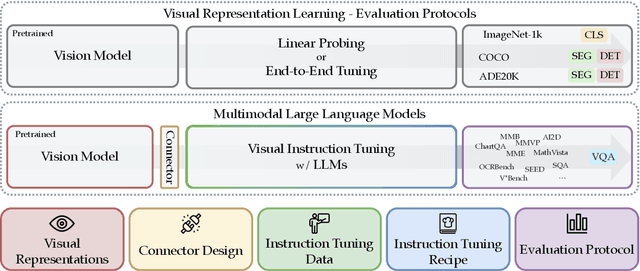



Abstract:We introduce Cambrian-1, a family of multimodal LLMs (MLLMs) designed with a vision-centric approach. While stronger language models can enhance multimodal capabilities, the design choices for vision components are often insufficiently explored and disconnected from visual representation learning research. This gap hinders accurate sensory grounding in real-world scenarios. Our study uses LLMs and visual instruction tuning as an interface to evaluate various visual representations, offering new insights into different models and architectures -- self-supervised, strongly supervised, or combinations thereof -- based on experiments with over 20 vision encoders. We critically examine existing MLLM benchmarks, addressing the difficulties involved in consolidating and interpreting results from various tasks, and introduce a new vision-centric benchmark, CV-Bench. To further improve visual grounding, we propose the Spatial Vision Aggregator (SVA), a dynamic and spatially-aware connector that integrates high-resolution vision features with LLMs while reducing the number of tokens. Additionally, we discuss the curation of high-quality visual instruction-tuning data from publicly available sources, emphasizing the importance of data source balancing and distribution ratio. Collectively, Cambrian-1 not only achieves state-of-the-art performance but also serves as a comprehensive, open cookbook for instruction-tuned MLLMs. We provide model weights, code, supporting tools, datasets, and detailed instruction-tuning and evaluation recipes. We hope our release will inspire and accelerate advancements in multimodal systems and visual representation learning.
Can 3D Vision-Language Models Truly Understand Natural Language?
Mar 28, 2024

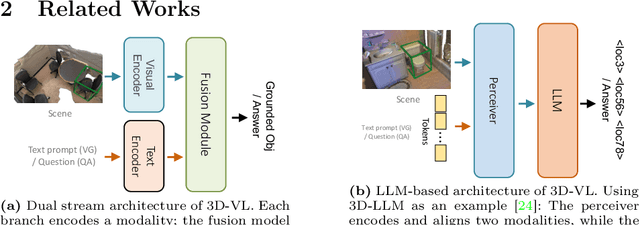
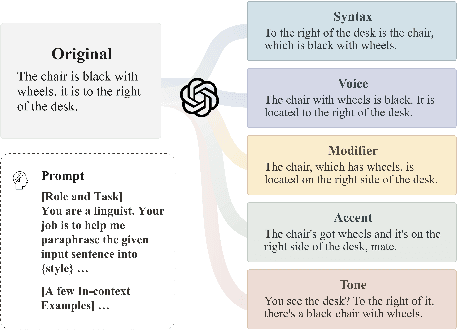
Abstract:Rapid advancements in 3D vision-language (3D-VL) tasks have opened up new avenues for human interaction with embodied agents or robots using natural language. Despite this progress, we find a notable limitation: existing 3D-VL models exhibit sensitivity to the styles of language input, struggling to understand sentences with the same semantic meaning but written in different variants. This observation raises a critical question: Can 3D vision-language models truly understand natural language? To test the language understandability of 3D-VL models, we first propose a language robustness task for systematically assessing 3D-VL models across various tasks, benchmarking their performance when presented with different language style variants. Importantly, these variants are commonly encountered in applications requiring direct interaction with humans, such as embodied robotics, given the diversity and unpredictability of human language. We propose a 3D Language Robustness Dataset, designed based on the characteristics of human language, to facilitate the systematic study of robustness. Our comprehensive evaluation uncovers a significant drop in the performance of all existing models across various 3D-VL tasks. Even the state-of-the-art 3D-LLM fails to understand some variants of the same sentences. Further in-depth analysis suggests that the existing models have a fragile and biased fusion module, which stems from the low diversity of the existing dataset. Finally, we propose a training-free module driven by LLM, which improves language robustness. Datasets and code will be available at github.
V-IRL: Grounding Virtual Intelligence in Real Life
Feb 05, 2024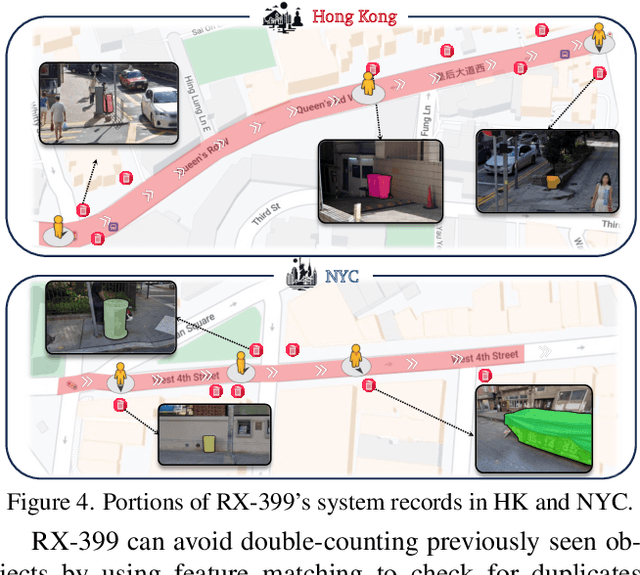
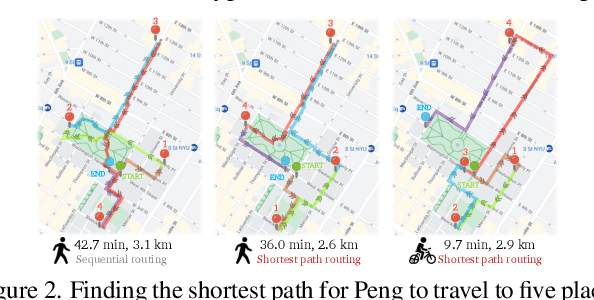
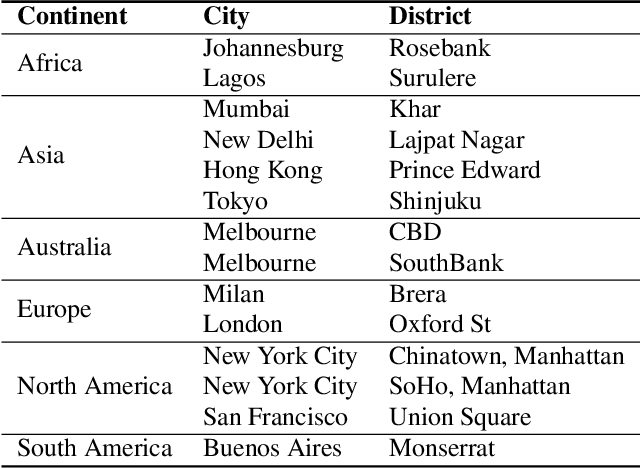
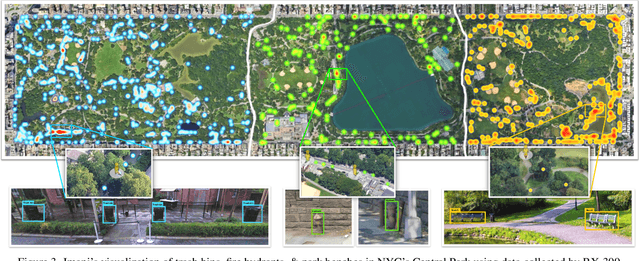
Abstract:There is a sensory gulf between the Earth that humans inhabit and the digital realms in which modern AI agents are created. To develop AI agents that can sense, think, and act as flexibly as humans in real-world settings, it is imperative to bridge the realism gap between the digital and physical worlds. How can we embody agents in an environment as rich and diverse as the one we inhabit, without the constraints imposed by real hardware and control? Towards this end, we introduce V-IRL: a platform that enables agents to scalably interact with the real world in a virtual yet realistic environment. Our platform serves as a playground for developing agents that can accomplish various practical tasks and as a vast testbed for measuring progress in capabilities spanning perception, decision-making, and interaction with real-world data across the entire globe.
Lowis3D: Language-Driven Open-World Instance-Level 3D Scene Understanding
Aug 01, 2023



Abstract:Open-world instance-level scene understanding aims to locate and recognize unseen object categories that are not present in the annotated dataset. This task is challenging because the model needs to both localize novel 3D objects and infer their semantic categories. A key factor for the recent progress in 2D open-world perception is the availability of large-scale image-text pairs from the Internet, which cover a wide range of vocabulary concepts. However, this success is hard to replicate in 3D scenarios due to the scarcity of 3D-text pairs. To address this challenge, we propose to harness pre-trained vision-language (VL) foundation models that encode extensive knowledge from image-text pairs to generate captions for multi-view images of 3D scenes. This allows us to establish explicit associations between 3D shapes and semantic-rich captions. Moreover, to enhance the fine-grained visual-semantic representation learning from captions for object-level categorization, we design hierarchical point-caption association methods to learn semantic-aware embeddings that exploit the 3D geometry between 3D points and multi-view images. In addition, to tackle the localization challenge for novel classes in the open-world setting, we develop debiased instance localization, which involves training object grouping modules on unlabeled data using instance-level pseudo supervision. This significantly improves the generalization capabilities of instance grouping and thus the ability to accurately locate novel objects. We conduct extensive experiments on 3D semantic, instance, and panoptic segmentation tasks, covering indoor and outdoor scenes across three datasets. Our method outperforms baseline methods by a significant margin in semantic segmentation (e.g. 34.5%$\sim$65.3%), instance segmentation (e.g. 21.8%$\sim$54.0%) and panoptic segmentation (e.g. 14.7%$\sim$43.3%). Code will be available.
 Add to Chrome
Add to Chrome Add to Firefox
Add to Firefox Add to Edge
Add to Edge